The Battle of Gettysburg… an intimate look…
November 7, 2022 by Laura Heilenman · Leave a Comment
I would imagine, as a journalist, an eyewitness is the “rare pearl”. Research is all well and good but interviewing someone who saw it with their own two eyes will most often give the very best information. So it was for the journalist who wrote for the DAILY RICHMOND EXAMINER, July 17, 1863 issue. The article…
“The Invasion of Pennsylvania–The Battle Of Gettysburg–The Retreat To Hagerstown” features an eye-witness account of the retreat and is prefaced with: “…the only connected, intelligent and intelligible account that has yet been given to the public of the movements of General Lee…after the Battle of Gettysburg.” This lengthy & detailed accounting by one of the soldiers begins with the Confederate advance from Virginia into Maryland on June 18, then continues with: “On Friday, 26th, we took up the line of march through Chambersburg on the Harrisburg road. The splendid band in the 4th Louisiana brigade…proceeded the column playing ‘Dixie” and the Marseillaise…We passed through Shippensburg to the sound of martial music again & went on to Carlisle…Harrisburg was in a panic…”.
A report from a soldier who was more than an eyewitness of the battle; rather, one who experienced it first-hand… From a journalist’s point of view, it just doesn’t get any better. 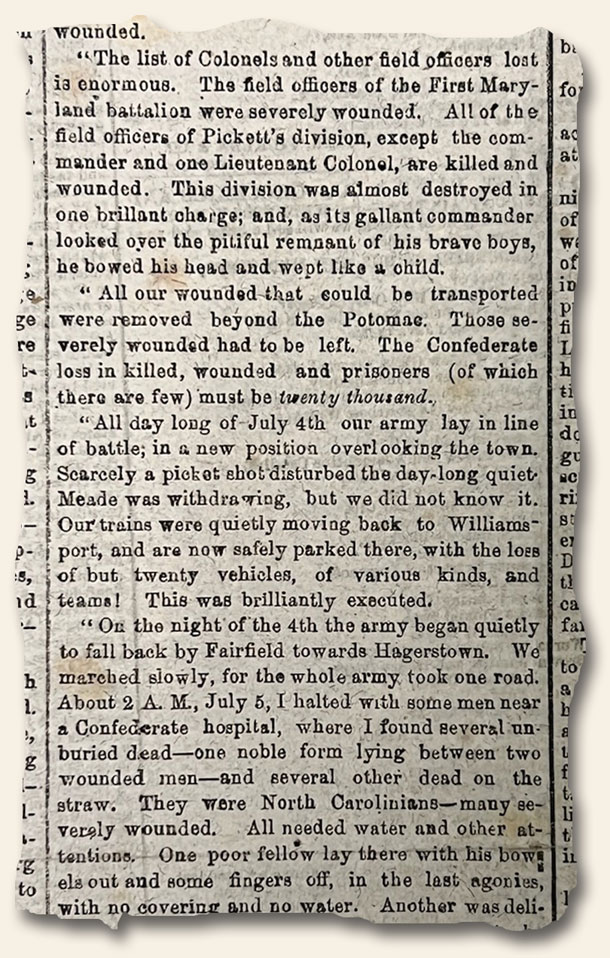
Who’s Who in Newspapers? Joseph A. Turner edition…
February 23, 2018 by GuyHeilenman · Leave a Comment
The 4th installment of Who’s Who in Newspapers:
George Washington, Benjamin Franklin, Alexander Hamilton… Babe Ruth, Jesse Owens, Vince Lombardi… John Wayne, James Dean, Katharine Hepburn – these individuals, among many, are easily recognizable. However, there are quite a few historical figures who, while having adorned the pages of many a newspaper, are far from household names. Such is the case with Joseph A Turner. Who is he? What was he known for? When did he live?
Mr. Turner just happens to be the publisher of what is believed to be the only Confederate newspaper printed/published on a Southern Plantation: The Countryman. He was the owner of Turnwold Plantation, located about 9 miles from Eatonton, Georgia – of Chick-fil-A, J.C.H. (see below), and The Color Purple fame.
As if this distinction were not enough, he took on Joel Chandler Harris – the eventual famed author of the Uncle Remus, Br’er Rabbit, and Br’er Fox stories, as an apprentice at the age of 14 – and trained him to serve as the typesetter for the newspaper.
Whenever we post an installment of “Who’s Who in Newspapers,” we typically provide a link to a chronological listing of newspapers which have information regarding the notable person in question. In this case, however, the newspapers are extremely rare, and while we do (at the time of this post) have a handful of issues, in this instance our link simply goes to a sample issue of this title:
THE COUNTRYMAN, by Joseph A. Turner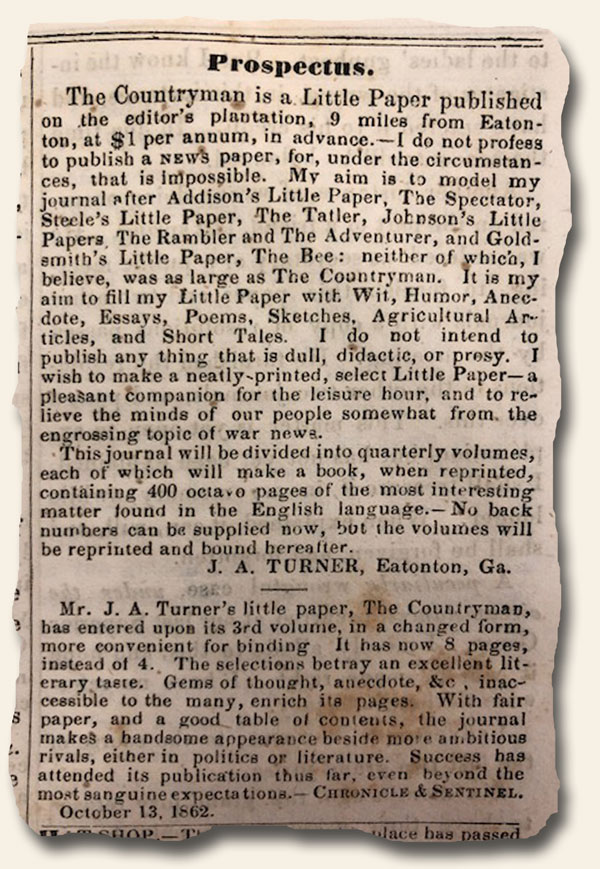
.
The (now) controversial Robert E. Lee monument unveiled in Richmond (1890)…
August 28, 2017 by GuyHeilenman · 1 Comment
 Whether or not the Robert E. Lee monument will remain in Richmond has yet to be determined, but considering the controversy, we thought it might be interesting to post the original Harper’s Weekly report from June 14, 1890 concerning the unveiling of the monument. The link provides the full text related to the image. The text reads, in part:
Whether or not the Robert E. Lee monument will remain in Richmond has yet to be determined, but considering the controversy, we thought it might be interesting to post the original Harper’s Weekly report from June 14, 1890 concerning the unveiling of the monument. The link provides the full text related to the image. The text reads, in part:
“The occasion of the unveiling of the Lee statue at Richmond, Virginia, on the 29th of May, possessed features that render it unique in history. It was a mighty tribute to the central figure of a lost-cause, attended by an undercurrent of satisfaction even that the cause was lost… The Confederate flag was everywhere conspicuously displayed… The military companies affectionately bore it in the line of march, but with it they bore the Stars and Stripes, and bore them loyally. The paradox is explainable only by the fact that the former no longer meant disunion… The opinion has with much reason been expressed that the occasion of such magnitude as the one described, with reference to the late Confederacy, is not likely ever to be repeated. General Lee personified what was best in a bad cause. His individual virtues gave the Southern people, who craved a demonstration commemorative of an indelible epoch in their lives, some substantial and unquestioningly credible to rally around. The honor to the hero of their vain struggle has been paid, and the full conditions for another gathering are wanting. It may therefore by surmised that in the great outpouring of the ex-Confederates at Richmond the final obsequies of the war of session have taken place, and the circumstances attending it show how completely the wounds of conflict have been healed, and a mist important chapter of American history closed. AMOS W. WRIGHT
When “white paper” was unavailable the presses kept running…
January 2, 2015 by TimHughes · Leave a Comment
We recently came across an interesting issue of “The Daily Rocky Mountain News” from Denver, dated Oct. 4, 1864. The uniqueness was not in the reporting; it was in the newspaper itself. Rather than printed on traditional newsprint stock, this issue is printed on pink-colored tissue paper. Fortunately, although very flimsy, it is not the least bit fragile.
 It was not unusual for print shops to run out of newsprint and to become inventive in finding ways to get out the day’s edition, particularly for newspapers in remote parts of the country as most paper mills were located in the Northeast. Think of the famous wallpaper issues from the Civil War. Some investigating came across the reason. One website on the history of the “Rocky Mountain News” noted that: “…When the Indian outbreak caused an embargo on traffic over the Western plains in 1864-5, he frequently ran out of white paper, and in such emergencies he printed the news on wrapping paper gathered from Denver stores…”. So this pink paper was wrapping paper. I wonder how long the need for “necessity paper” lasted. We also have two more issues with a similar date which are printed on yellow and green paper. In any case, very interesting curiosities for this fascinating hobby.
It was not unusual for print shops to run out of newsprint and to become inventive in finding ways to get out the day’s edition, particularly for newspapers in remote parts of the country as most paper mills were located in the Northeast. Think of the famous wallpaper issues from the Civil War. Some investigating came across the reason. One website on the history of the “Rocky Mountain News” noted that: “…When the Indian outbreak caused an embargo on traffic over the Western plains in 1864-5, he frequently ran out of white paper, and in such emergencies he printed the news on wrapping paper gathered from Denver stores…”. So this pink paper was wrapping paper. I wonder how long the need for “necessity paper” lasted. We also have two more issues with a similar date which are printed on yellow and green paper. In any case, very interesting curiosities for this fascinating hobby.
Some back-handed compliments for Abe Lincoln…
August 2, 2013 by TimHughes · Leave a Comment
The June 5, 1860 issue of the “New York Tribune” has two testimonials as to the character of Abraham Lincoln, to be the Republican nomination for President in the up-coming election. The second report is by the Honorable George Ashmun and offers some interesting comments. Also, “The Daily Delta” from New Orleans, issue of Feb. 27, 1861 has an equally back-handed “compliment” on the appearance of Lincoln (see below), noting he: “…is not handsome by a great many degrees,but he has not that hideous, ugly look which his portraits give him…”: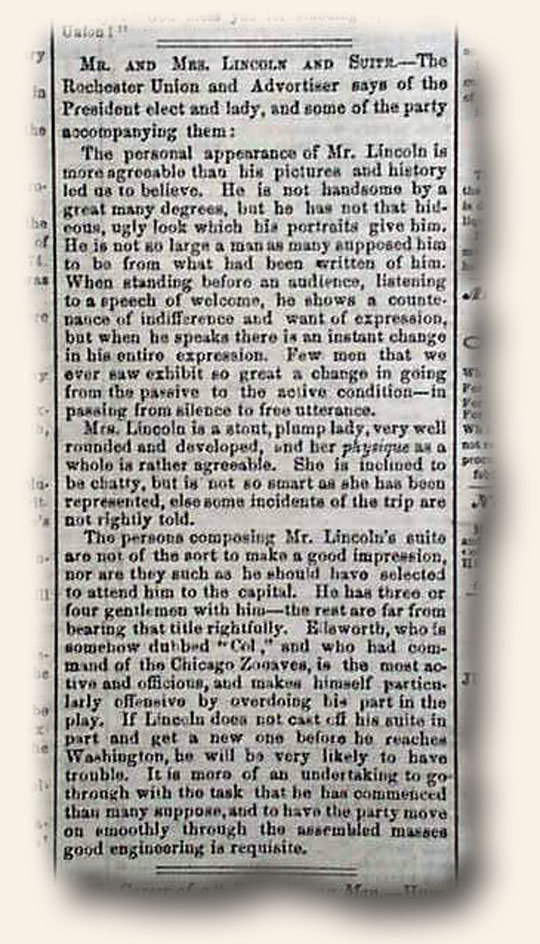
The editor shows his bias…
July 26, 2013 by TimHughes · Leave a Comment
Editorials from the 19th century were often quite frank and not afraid to mince words, and perhaps the most scathing comments were found in newspapers during the Civil War years. The “Daily Examiner” newspaper from Richmond, Virginia, January 20, 1865, has an editorial which begins with some very biased words about Andrew Johnson: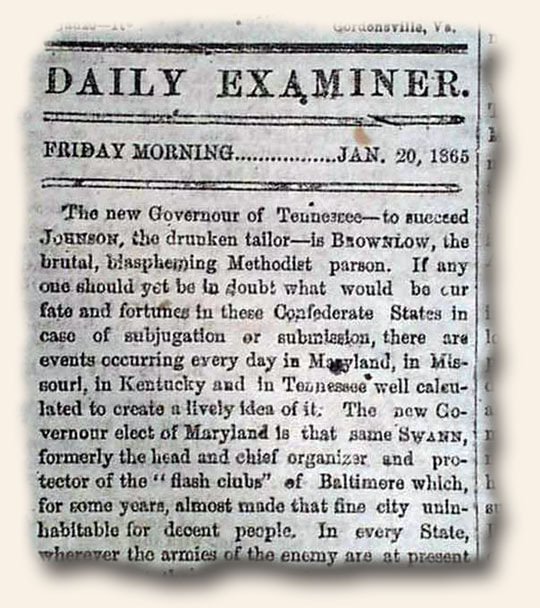
Gettysburg revisted… 150 years ago…
June 28, 2013 by GuyHeilenman · 2 Comments
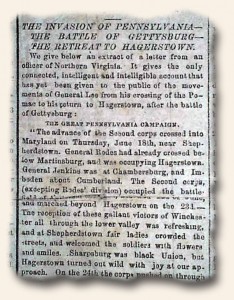 Since the birth of the United States, there may not be a single more formative event than The Battle of Gettysburg. Authentic newspapers containing first-hand accounts continue to be one of the most sought after within the collectible. Over the years several History’s Newsstand posts have been written about these contemporary reports. A sample of a few are:
Since the birth of the United States, there may not be a single more formative event than The Battle of Gettysburg. Authentic newspapers containing first-hand accounts continue to be one of the most sought after within the collectible. Over the years several History’s Newsstand posts have been written about these contemporary reports. A sample of a few are:
The ultimate optimist…
Beyond the big, historic headline…
The Civil War…
The “top ten”: 19th century…
Most historic Civil War event…
The following are the currently available original newspapers with reports related to the Battle of Gettysburg. Please enjoy a brief walk into the heart of “America in crisis” (arranged in chronological order): Battle of Gettysburg
The Traveler… Conferedate president issues a proclamation… new establishments……
March 4, 2013 by The Traveler · Leave a Comment
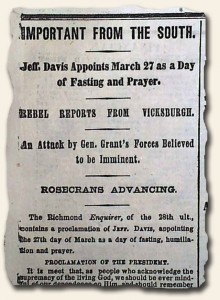 Today I decided to travel back to the era of the Civil War through The New York Times of March 4, 1863. In this issue I found the Southern President Jeff Davis had appointed March 27th to be a Day of Fasting and Prayer. “…Under these circumstances it is my privilege to invite you once more to meet together and prostrate yourselves in humble supplication to Him who has been our constant and never-failing support in the past, and to whose protection and guidance we trust for the future. To this end I, Jefferson Davis, President of the Confederate States of America, do issue this, my proclamation, setting apart Friday, the 27th day of March, as a day of fasting, humiliation and prayer…” This is also signed in type: JEFFERSON DAVIS.
Today I decided to travel back to the era of the Civil War through The New York Times of March 4, 1863. In this issue I found the Southern President Jeff Davis had appointed March 27th to be a Day of Fasting and Prayer. “…Under these circumstances it is my privilege to invite you once more to meet together and prostrate yourselves in humble supplication to Him who has been our constant and never-failing support in the past, and to whose protection and guidance we trust for the future. To this end I, Jefferson Davis, President of the Confederate States of America, do issue this, my proclamation, setting apart Friday, the 27th day of March, as a day of fasting, humiliation and prayer…” This is also signed in type: JEFFERSON DAVIS.
Also under the “Important from Washington” are the new establishments of “The New Banking Law”; “Designs for Currency Notes” due to the recent passing of the National Currency Act; “A Branch Mint in Nevada”; as well as the establishing of “The Territory of Idahoe (Idaho)” from within the territory of Montano (Montana). “Slavery is forever prohibited within the limits of the new Territory”.
What an incredible time in history!
~The Traveler
Newspaper Confederate bank note creates a crisis…
October 1, 2012 by TimHughes · 2 Comments
Having recently come across the Feb. 24, 1862 issue of “The Philadelphia Inquirer” (see photo) it reminded me of what this innocent looking front page image of the Confederate five dollar note did in creating a crisis in the Confederate Treasury.
Several months ago the “Opinionator” blog of the New York Times did a very nice piece on the fascinating history of this note and its consequences, which we share with our collectors:
 In March 1862, an unusual ad began appearing in Northern newspapers. Among the shops selling pianos and patent medicines, sheet music and sewing machines, this one stood out: it promised “perfect fac-similes” of Confederate currency. There were seven kinds of notes for sale, and testimonials from The New York Tribune and others praising the replicas for their high quality and low prices. Five cents bought you one. Two dollars bought a hundred. Fifteen dollars bought a thousand. The word “counterfeits” never appeared. These were “Mementos of the Rebellion,” sold by a Philadelphia shopkeeper named Samuel Curtis Upham.
In March 1862, an unusual ad began appearing in Northern newspapers. Among the shops selling pianos and patent medicines, sheet music and sewing machines, this one stood out: it promised “perfect fac-similes” of Confederate currency. There were seven kinds of notes for sale, and testimonials from The New York Tribune and others praising the replicas for their high quality and low prices. Five cents bought you one. Two dollars bought a hundred. Fifteen dollars bought a thousand. The word “counterfeits” never appeared. These were “Mementos of the Rebellion,” sold by a Philadelphia shopkeeper named Samuel Curtis Upham.
Upham didn’t look like a counterfeiter. He didn’t hide out in the woods or perform daring jailbreaks. He didn’t run from the police. He was a respectable small-business owner and devoted Northern patriot. He ran a store that sold stationery, newspapers and cosmetics. But he was also an entrepreneur with an eye for easy profit, and the Civil War offered the business opportunity of a lifetime: the ability to forge money without breaking the law. Confederate currency, issued by a government that was emphatically not recognized by the Union, had no legal status in the North, which meant Upham could sell his “fac-similes” with impunity.
Over the next 18 months he built the most notorious counterfeiting enterprise of the Civil War — one that also happened to be perfectly legal. His forgeries flooded the South, undermining the value of the Confederate dollar and provoking enraged responses from Southern leaders. He waged war on the enemy’s currency, serving his pocketbook and his country at the same time.
Upham first got the idea the month before, on Feb. 24, 1862. That day, customers kept coming into his shop to buy The Philadelphia Inquirer. Puzzled, he asked one of them what made that particular edition so popular. The answer was on the front page: the Inquirer’s editors had printed a copy of a five-dollar Confederate note. Philadelphians had never seen Rebel money before and were fascinated by it.
Upham saw a chance to cash in. He raced to the Inquirer’s offices, bought the plate of the note, and printed 3,000 copies on French letter paper. They sold extremely well. Along the bottom of each bill, he included a thin strip that read, in small print, “Fac-simile Confederate Note,” with his name and address. The tags could easily be clipped off, transforming the “fac-simile” into an excellent counterfeit.
After his first print run, Upham rapidly expanded his inventory. He took out ads in newspapers, promising to pay in gold for more specimens of Southern money. At first, it seemed possible that he sincerely thought of his reproductions as souvenirs. In early 1862, most Northerners still expected the war to be brief and glorious. They wanted “mementos of the Rebellion” before the Union crushed it. By the time Upham launched his publicity campaign in March, however, his business had clearly evolved from a modest retail operation into a high-volume wholesaling enterprise. No one needed 1,000 souvenirs: people were clearly using his products for a less innocent purpose.
By April, Upham’s fakes began appearing in Richmond, the Confederate capital. They caused a sensation at the Confederate Treasury Department, and a Treasury officer persuaded the editors of the Richmond Daily Dispatch to inform the public about the new threat. “This note is well calculated to deceive, and in nearly every particular is a fac-simile of the original,” they wrote, condemning the forgeries as “Yankee scoundrelism.” In May, the Dispatch discovered one of Upham’s notes with the margin bearing his name and address still attached. “Who is this man Upham?” they asked. “A knave swindler, and forger of the most depraved and despicable sort.”
By then, Upham had grown his business considerably. In an advertisement published in late May, he claimed to have sold half a million notes in the past three months. He now offered 14 varieties of Confederate notes, postage stamps, and “shinplasters” — fractional bills worth anywhere from 5 to 15 cents — and printed his fakes on real banknote paper. Ingeniously, he even fulfilled orders through the mail. For 50 cents, plus 18 cents for postage, customers throughout the Union could have a hundred of Upham’s notes delivered.
Southerners responded with outrage. They became convinced that Upham belonged to a covert Union plot to devalue the Confederate dollar. For the Philadelphia shopkeeper to be able to advertise his counterfeits openly and send them through the mail meant the authorities must have given him permission or, possibly, material support. Moreover, Union troops spent counterfeit Confederate cash in large quantities — evidence of “a deep laid scheme on the part of the thieving, counterfeiting North … to undermine the Confederate currency,” in the eyes of the Daily Richmond Examiner.
In the summer of 1862, Upham’s notes inundated northern Virginia, brought by Union forces marching south from Washington. A Southern journalist observed men “fortified with exhaustless quantities of Philadelphia Confederate notes,” which they used to buy everything from horses to sugar to tobacco. When one of the soldiers ended up a prisoner in Richmond, the Confederates found one of Upham’s advertisements on him. The shopkeeper’s counterfeits appeared “wherever an execrable Yankee soldier polluted the soil with his cloven foot,” fumed the Richmond Daily Dispatch.
By the summer of 1862, as fake cash flowed across the border in ever greater quantities, the Confederate leadership took notice. On Aug. 18, President Jefferson Davis discussed the threat in a message to the Confederate Congress. Counterfeit Confederate notes were “publicly advertised for sale” and furnished to “the soldiers of the invading army” with the full “complicity” of the Union government, Davis declared. Later that day, Confederate Treasury Secretary Christopher Memminger submitted a report to the House of Representatives that reiterated Davis’s concerns and singled out Upham’s role in the crisis: “[P]rinted advertisements have been found stating that the counterfeit notes, in any quantity, will be forwarded by mail from Chestnut street, in Philadelphia.” By then, forged bills had been found far from the Union border, in Atlanta, Savannah, Montgomery and other cities of the Deep South. There was “no means of knowing to what extent they have been circulated,” the Richmond Daily Dispatch warned.
Hamstrung by a disorganized government and mounting logistical challenges, the Confederacy couldn’t stanch the surge of counterfeit currency. Despite Southern claims, however, it’s unlikely that the Union government ever actively promoted the forging of Confederate money. Federal authorities most likely found it easier to ignore the forging of Southern bills than to take a position either for or against it. They certainly never interfered with Upham, who freely continued forging Confederate cash until August 1863. By that time, the value of the Southern dollar had fallen so low that it was hardly worth counterfeiting. During the 18 months that Upham operated his venture, the purchasing power of the Confederate dollar disintegrated. Between February 1862 and August 1863, the value of Confederate paper money fell by ninety percent.
Upham wasn’t the only reason behind this collapse. Fake cash plagued the Confederacy from the beginning, supplied by Northern and Southern counterfeiting gangs. Gross mismanagement of Southern finances led to runaway inflation, which posed an even greater danger to the Confederate dollar. But Upham’s impact was significant. He later estimated that he had produced $15 million worth of Confederate bills. If all of that ended up in the South, it would have made up almost 3 percent of the total money supply — a large amount for a single counterfeiter. In March 1862, his business had only just begun. Over the next year and a half, he would become one of the strangest success stories of the Civil War: a legal counterfeiter, driven by patriotism and personal gain, who struck at the financial heart of the Confederacy from the safety of downtown Philadelphia.
Southern Illustrated News images on Pinterest…
April 20, 2012 by GuyHeilenman · 2 Comments
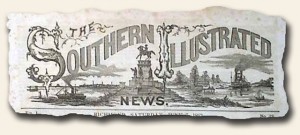 The Southern Illustrated News (Richmond, Virginia) was the Confederate counterpart to Harper’s Weekly Illustrated (NY, New York). While its distribution and duration were limited, the issues have become quite collectible. Portraits of Stonewall Jackson, Robert E. Lee, John S. Mosby, J.E.B Stuart, John H. Morgan, along with nearly every other notable figure from the Confederacy adorned the front page of this highly sought-after publication. Rare & Early Newspapers has taken on the task of posting images of every issue on Pinterest. While this project may take years, feel free to enjoy the progress to-date at: The Southern Illustrated News on Pinterest.
The Southern Illustrated News (Richmond, Virginia) was the Confederate counterpart to Harper’s Weekly Illustrated (NY, New York). While its distribution and duration were limited, the issues have become quite collectible. Portraits of Stonewall Jackson, Robert E. Lee, John S. Mosby, J.E.B Stuart, John H. Morgan, along with nearly every other notable figure from the Confederacy adorned the front page of this highly sought-after publication. Rare & Early Newspapers has taken on the task of posting images of every issue on Pinterest. While this project may take years, feel free to enjoy the progress to-date at: The Southern Illustrated News on Pinterest.


